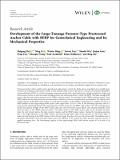| dc.contributor.author | Du, Zhigang | |
| dc.contributor.author | Li, Ning | |
| dc.contributor.author | Tao, Yawen | |
| dc.contributor.author | Wu, Xiaolei | |
| dc.contributor.author | Guo, Jinjun | |
| dc.contributor.author | You, Peng | |
| dc.contributor.author | Wang, Chaoqin | |
| dc.contributor.author | Archbold, Paul | |
| dc.contributor.author | Mullarney, Brian | |
| dc.contributor.author | Xie, Bing | |
| dc.date.accessioned | 2022-10-11T09:10:54Z | |
| dc.date.available | 2022-10-11T09:10:54Z | |
| dc.date.copyright | 2022 | |
| dc.date.issued | 2022 | |
| dc.identifier.citation | Du, Z., Li, N., Ding, W., Tao, Y., Wu, X., Guo, J., You, P., Wang, C., Archbold, P., Mullarney, B., Xie, B. (2022). Development of the large-tonnage pressure-type prestressed anchor cable with BFRP for geotechnical engineering and its mechanical properties. Geofluids.Volume 2022, Article ID 7467842, 13 pages https://doi.org/10.1155/2022/7467842 | en_US |
| dc.identifier.issn | 1468-8115 | |
| dc.identifier.uri | http://research.thea.ie/handle/20.500.12065/4068 | |
| dc.description.abstract | Prestressed anchor cable is widely used in geotechnical engineering to control the displacement or landslide of an unstable slope.
However, the traditional cable anchor is made of steel material, which is easy to get rust in a corrosive environment. Basalt fiberreinforced plastics (BFRP) are a kind of emerging compound material, with a good performance of high strength, low weight, and
anticorrosion. Herein, an innovative large-tonnage pressure-type prestressed anchor is made with BFRP. This large-tonnage BFRP
anchor cable has seven bunch structures of the “BFRP-connector-strand.” In each bunch of the “BFRP-connector-strand,” three
BFRP tendons and one steel strand are connected inside a steel sleeve connector using the epoxy resin adhesive. The ultimate loadbearing capacity of this BFRP cable anchor can reach 202.38 tonnages. At the ultimate tensioning force condition, the strain of
BFRP tendons for this large-tonnage BFRP anchor cable ranges from 1.51% to 1.76%. In the tensioning operation, there is a
linear growth relationship between the tensioning force and the strain for this BFRP cable anchor. Once the tensioning force
reaches the ultimate strength of this BFRP anchor cable, this cable will present system failure. This situation primarily results
from the failure of the “BFRP-connector-strand.” The failure modes of this BFRP anchor cable can be classified into three
types: the steel strand rupture, the steel connector rupture, and the BFRP tendon rupture. During the tensioning operation,
due to the length difference of the BFRP tendons, this large-tonnage BFRP cable anchor presents an end-off-axis effect. It
makes the load bearing of the BFRP tendons 5.00~6.60 times larger than that of the no end-off-axis effect. Nevertheless, due to
the plastic deformation of the end steel anchor sleeve, the influence of the end-off-axis effect decreases with the increase of
applied tensioning force. The load-bearing capacity of this large-tonnage BFRP cable anchor reaches 87.70~91.50% of its
theoretical value. | en_US |
| dc.format | PDF | en_US |
| dc.language.iso | eng | en_US |
| dc.publisher | Wiley/Hindawi | en_US |
| dc.relation.ispartof | Geofluids | en_US |
| dc.rights | Attribution-NonCommercial-NoDerivatives 4.0 International | * |
| dc.rights.uri | http://creativecommons.org/licenses/by-nc-nd/4.0/ | * |
| dc.subject | Prestressed anchor cable | en_US |
| dc.subject | Geotechnical engineering | en_US |
| dc.subject | Basalt fiber reinforced plastics (BFRP) | en_US |
| dc.title | Development of the large-tonnage pressure-type prestressed anchor cable with BFRP for geotechnical engineering and its mechanical properties | en_US |
| dc.type | info:eu-repo/semantics/article | en_US |
| dc.contributor.affiliation | Technological University of the Shannon Midlands Midwest | en_US |
| dc.contributor.sponsor | This study has been sponsored financially by the Natural Science Foundation of Henan Province (Project no. 222300420242), the Science and Technology Development Project of Luoyang (Project no. 2101025A), the Heluo Young Talent Lifting Project of Society and Technology Association of Luoyang (Project no. 2022HLTJ06), the Science and Technology Innovation Leading Talent Project of Zhongyuan (Project no. 214200510030), and the Key Research and Development Project of Henan Province (Project no. 221111321500). | en_US |
| dc.description.peerreview | yes | en_US |
| dc.identifier.doi | 10.1155/2022/7467842 | en_US |
| dc.identifier.eissn | 1468-8123 | |
| dc.identifier.orcid | https://orcid.org/0000-0003-2464-7258 | en_US |
| dc.identifier.orcid | https://orcid.org/0000-0002-2772-3271 | en_US |
| dc.rights.accessrights | info:eu-repo/semantics/openAccess | en_US |
| dc.subject.department | Faculty of Engineering and Informatics TUS:MM | en_US |
| dc.type.version | info:eu-repo/semantics/publishedVersion | en_US |


